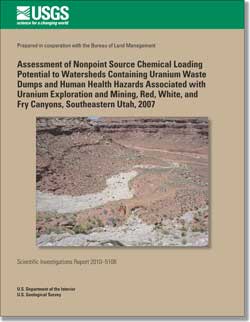 Abstract Abstract
During May, June, and July 2007, 58 solid-phase samples were collected from abandoned uranium mine waste dumps, background sites, and adjacent streambeds in Red, White, and Fry Canyons in southeastern Utah. The objectives of this sampling program were to (1) assess the nonpoint-source chemical loading potential to ephemeral and perennial drainage basins from uranium waste dumps and (2) assess potential effects on human health due to recreational activities on and around uranium waste dumps on Bureau of Land Management property. Uranium waste-dump samples were collected using solid-phase sampling protocols. After collection, solid-phase samples were homogenized and extracted in the laboratory using a leaching procedure. Filtered (0.45 micron) water samples were obtained from the field leaching procedure and were analyzed for major and trace elements at the Inductively Coupled Plasma-Mass Spectrometry Metals Analysis Laboratory at the University of Utah. A subset of the solid-phase samples also were digested with strong acids and analyzed for major ions and trace elements at the U.S. Geological Survey Geologic Division Laboratory in Denver, Colorado.
For the initial ranking of chemical loading potential for uranium waste dumps, results of leachate analyses were compared with existing aquatic-life and drinking-water-quality standards. To assess potential effects on human health, solid-phase digestion values for uranium were compared to soil screening levels (SSL) computed using the computer model RESRAD 6.5 for a probable concentration of radium. One or more chemical constituents exceeded aquatic life and drinking-water-quality standards in approximately 64 percent (29/45) of the leachate samples extracted from uranium waste dumps. Most of the uranium waste dump sites with elevated trace-element concentrations in leachates were located in Red Canyon. Approximately 69 percent (31/45) of the strong acid digestible soil concentration values were greater than a calculated SSL. Uranium waste dump sites with elevated leachate and total digestible concentrations may need to be further investigated to determine the most appropriate remediation method.
|
Part or all of this report is presented in Portable Document Format (PDF); the latest version of Adobe Reader or similar software is required to view it. Download the latest version of Adobe Reader, free of charge. |